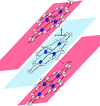issue contents
February 2017 issue

Cover illustration: 2,2'-Thiodiacetic acid (Tda) deprotonates ethylenediamine and o-phenylenediamine to form anions with different valencies and different supramolecular networks. In the former, divalent Tda2- anions form one-dimensional linear supramolecular chains and these are extended into a three-dimensional sandwich-type supramolecular network by interaction with ethylenediaminium cations. However, in the latter, monovalent Tda- anions form one-dimensional zigzag supramolecular chains, which are extended into a three-dimensional supramolecular network by interaction with 2-aminoanilinium cations. See Gomathi & Theivarasu [Acta Cryst. (2017), C73, 97-103].
research papers




















 journal menu
journal menu


























